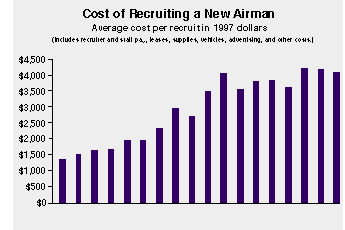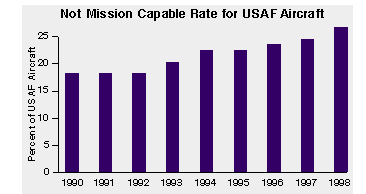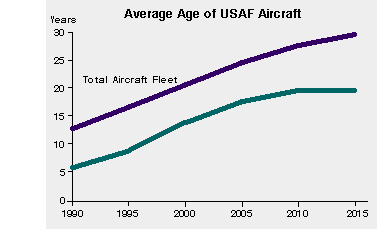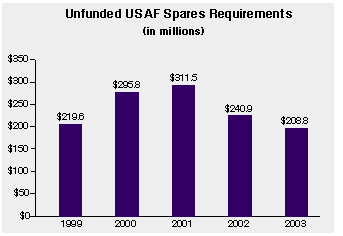Within Pacific Air Forces alone, the cost to fill the shortage of individual protective equipment for chemical-biological warfare is $7.2 million. Air Force wide, the rate of cannibalization–taking parts off one airplane to fix another–is up by 58 percent since 1995.
The Marine Corps says it cannot afford new tires for the Humvees and 5-ton trucks of expeditionary forces. It’s buying retreads instead. The Navy says that it is concerned about its stocks of modern munitions. Tomahawk cruise missiles are in particularly short supply.
As these examples show, the US military’s readiness now appears to be sliding quickly downhill. The situation has reached the point where the chiefs of all the services have started to publicly sound the alarm in Congress and in encounters with top Clinton Administration officials.
Lawmakers generally agree that more money is needed to keep the armed services in fighting trim, but some complained earlier this fall that they had been taken by surprise at a Sept. 29 hearing when they detected a sharp change in tone from the nation’s uniformed leadership about the extent of readiness problems.
The military’s can-do attitude, plus the reluctance of lower ranks to tell the brass bad news, made this situation worse than it needed to be, according to Sen. John McCain (R-Ariz.), a leading member of the Senate Armed Services Committee.
The Silent Men
McCain and others on Capitol Hill were disturbed that the chiefs did not emphasize the readiness problem earlier. “All of us know these problems did not arise in the last seven months,” he said. “They’ve been going on for a number of years.”
The basic elements of the developing readiness crisis have been well-known since the mid-1990s. They include the demands of a high operations tempo, underfunded operations and maintenance accounts, and the exodus of key personnel drawn by the money and benefits of the civilian economy and, in many cases, disenchantment with Administration policies.
Each of the armed services suffers its own unique mix of readiness problems, but general risks affect them all, according to a readiness report compiled by McCain and his staff. These risks include:
The optempo illusion. Laymen might think that deployment on a real-world mission, to peacekeeping duty in Bosnia or no-fly zone enforcement over Iraq, would be the best training that a US military unit could ever receive. In fact, almost the opposite is true. Large amounts of varied training–as opposed to a routine of overflights, or patrols-are needed to keep readiness rates at a high level.
The Air Force, though much smaller, handles an optempo four times greater than it experienced in the Cold War, and much of that activity stems from routine flights enforcing no-fly zones over Iraq and monitoring the airspace around and over Bosnia.
The Navy, for its part, now deploys from home port more than 50 percent of its fleet on any given day, up from about 37 percent in 1992. That fact has contributed to a decline in nondeployed readiness in the sea service, according to the Chief of Naval Operations, Adm. Jay L. Johnson.
At the same time, the life turbulence caused by extended deployments has become the No. 1 reason that personnel of all levels are leaving US military service. “Family separation” was the top choice among reasons for leaving cited by departing Navy sailors in 1997, for instance.
Increasing depot maintenance backlogs. All of the services have seen in recent years a steady climb in the backlog of weapons and major parts awaiting depot repair, despite the fact that the size of the force has shrunk during that time.
The Defense Department backlog now has reached $1.6 billion, compared to $420 million in 1991, according to McCain’s report.
 The Air Force slice of this backlog is projected to hit $323 million in Fiscal 1999. The problem particularly affects ground communications equipment special purpose vehicles, some component repair, and readiness spare packages. Aircraft and engine overhaul and missile repair receive priority, thus the 1999 backlog is projected to include only 25 aircraft and 106 engines.
The Air Force slice of this backlog is projected to hit $323 million in Fiscal 1999. The problem particularly affects ground communications equipment special purpose vehicles, some component repair, and readiness spare packages. Aircraft and engine overhaul and missile repair receive priority, thus the 1999 backlog is projected to include only 25 aircraft and 106 engines.
The extent of the depot jam-up, however, means that any unexpected problem can quickly escalate into a major headache. A technical surprise, for instance, recently affected the engines on F-15Es based at RAF Lakenheath in Britain. Because of the depot backlog, the Air Force told McCain’s staff, “The F-15E squadrons at Lakenheath remained at a low state of readiness for over a year.”
Underfunded quality-of-life programs. Money needed to make life better for the men and women of the US armed services is increasingly tight these days. The estimated 14 percent pay shortfall, when measured against comparable civilian jobs, is only part of the story.
 Reductions in military retired pay have made it more difficult to retain qualified personnel, according to the chiefs. So has the institution of the Tricare health care system, which service chiefs described as falling short of their troops’ needs and wants.
Reductions in military retired pay have made it more difficult to retain qualified personnel, according to the chiefs. So has the institution of the Tricare health care system, which service chiefs described as falling short of their troops’ needs and wants.
Said Gen. Dennis J. Reimer, the Army chief of staff, in his reply to McCain’s questions: “The loss in medical benefits when a retiree turns 65 is particularly bothersome to our soldiers when making career decisions.”
A recent poll of Air Force pilots who have indicated a desire to leave the service found that a perceived decline in quality of life trailed only high optempo as a reason to separate from the service. A survey by the Air Force Chief of Staff found that only 26 percent of Air Force enlisted personnel judge the retirement system as fair and equitable.
Underfunded base maintenance and repair. Weapons may deliver the blow, but buildings, piers, barracks, and runways are important underpinnings of US military power as well. According to McCain’s report, maintenance of this infrastructure has been squeezed in recent years as all the services struggled to balance the needs of modernization, operations, and repairs.
At Dyess AFB, Texas, the B-1 avionics shop’s air-conditioning and electrical power are not adequate for workers to perform their mission. Hundreds of avionics “black boxes” are having to be shipped off base for repairs.
 Leaks in the roof in the communications systems repair facility at Offutt AFB, Neb., have caused delays in repairs for Air Force air traffic control equipment. The only enlisted dining facility at Edwards AFB, Calif., was recently closed due to deteriorating sanitary and health conditions.
Leaks in the roof in the communications systems repair facility at Offutt AFB, Neb., have caused delays in repairs for Air Force air traffic control equipment. The only enlisted dining facility at Edwards AFB, Calif., was recently closed due to deteriorating sanitary and health conditions.
Air Force commanders are having particular trouble with aging water and sewer systems.
“A notable example is a failure in the Minot AFB [N.D.] water system in late spring 1998, which resulted in the base running out of drinking water,” officials told McCain’s staff. “A 40-year-old line ruptured, resulting in base water tanks draining to less than 20 percent of capacity.”
The Army projects it can pay for only 58 percent of base repair needs in 1999. The Marines say their current budget would pay for the replacement of typical base systems once every 200 years.
Underfunded weapons modernization. For years, tight budgets have meant that service weapons procurement accounts have been squeezed. With major new systems purchased during the buildup of the early 1980s still on hand, the Pentagon leadership was content to save what money it could from a “procurement holiday” while planning on a spending ramp-up at some unspecified point in the future.
That point is now here. Many major systems have now reached, or surpassed, retirement age.
“We have reached a critical point in the life cycle of our ground and aviation equipment,” said Marine Corps Commandant Gen. Charles C. Krulak. “We are facing virtual block obsolescence of crucial items.”
The average age of a Marine amphibious assault vehicle exceeds its programmed life span by seven years. Marine CH-53D helicopters are 30 years old on average, well past the end of their projected service life.
 For the Air Force, the average age for all aircraft in the fleet will be 20 years in 2000. In 2015, it will be 30 years, even taking into account planned purchases of F-22s and Joint Strike Fighters. The age of the Air Force aircraft fleet has never been anywhere near that high, said officials.
For the Air Force, the average age for all aircraft in the fleet will be 20 years in 2000. In 2015, it will be 30 years, even taking into account planned purchases of F-22s and Joint Strike Fighters. The age of the Air Force aircraft fleet has never been anywhere near that high, said officials.
Replacing systems may be expensive-but so is not replacing them. As technology-laden weapons such as fighter aircraft age, they become more expensive to maintain, driving up maintenance budgets. Depot maintenance for the oldest F-15s in the Air Force inventory, A/B models averaging 21 years old, costs about 40 percent more than similar upkeep for newer F-15Es.
The McCain report concludes that equipment readiness rates are now being kept up only because of dedicated service personnel who work 12- to 16-hour days, on overlapping shifts, seven days a week, to keep things going.
The study’s list of critical modernization needs is an extensive one, including improved strategic lift, precision guided munitions, bomber force upgrades, fighter aircraft, and space initiatives for the Air Force; troop and amphibious lift, amphibious vehicles, and fire support for the Marines; improved fighter/strike aircraft, mine warfare, interoperability and battle management, and increased shipbuilding rates for the Navy; and force digitization, increased lethality of ground weapon systems, and improved attack and other combat helicopters for the Army.
Underfunded munitions stocks. Purchase of new munitions has suffered the same budget woes as weapons procurement. In general, all the services have simply redefined their stocks on hand as adequate to supply a force structure that has steadily gotten smaller anyway, according to McCain’s readiness report.
Ryan, the Air Force Chief of Staff, wrote that “we lived off the surplus from the 40 percent drawdown of our forces in the early ’90s,” although munitions funding is no longer adequate. In two cases–30 mm ammunition and LUU-2 flares–low munitions levels have lowered mission ready crew status, according to the Air Force.
The Navy is worried about low stocks of modern precision guided weaponry, particularly the Tomahawk Block III missile. Its munitions inventories are such that some units receive only one training missile per year of expensive leading edge weapons.
Budgetary sleight of hand. The delicate balancing act required to try and keep today’s military ready while preparing for the future leads to budget trade-offs which are not acceptable, according to the McCain study.
Take the funding of real-world operations, such as the deployment to Bosnia. While Congress will theoretically pass supplemental appropriations legislation to cover the cost of such add-ons, in practice more money goes out than comes in. The Army will only get about 90 cents back for every dollar it spends in Bosnia, for instance, according to service estimates.
 The Air Force suffers the same problem. In Fiscal 1996, the Air Force spent $779 million on snap operations and got back $712 million, for a $67 million shortfall. In Fiscal 1997, the service spent $852 million and received $827 million, for a $25 million gap.
The Air Force suffers the same problem. In Fiscal 1996, the Air Force spent $779 million on snap operations and got back $712 million, for a $67 million shortfall. In Fiscal 1997, the service spent $852 million and received $827 million, for a $25 million gap.
“The shortfalls were sourced from other USAF programs,” notes an Air Force response to a question on the subject.
Another budget trick that may hurt readiness is the military’s tendency to spend savings before they are achieved. Out-year budget plans are particularly prone to such wishful thinking. The Army, for instance, has already programmed $10.5 billion worth of savings to be gained from unspecified management efficiencies into its Future Years Defense Program.
“[T]hese are risks associated with this budget,” Reimer noted in February, when outlining his spending plans to the Senate Armed Services Committee.
Still Formidable
All the service chiefs insist that their forces are still able to carry out their missions if the nation calls. Forward deployed units, and those now carrying out missions for the nation in far corners of the globe, get almost all of the money, parts, and weapons they need.
The problem is decay around the edges, as nondeployed units begin to suffer.
“Since 1996, we have experienced an overall 14 percent degradation in our operational readiness of our major operational units,” Ryan told the Senate Armed Services Committee on Sept. 29. “This is especially true of stateside units who are prioritized lower than the overseas and engaged units.”
“My greatest concern is for our people. … We are losing too many of our experienced people now,” continued Ryan.
Other services see similar problems. The Navy is experiencing its lowest nondeployed readiness rates for carrier air wings in a decade. The Army said it needs $3 billion to $5 billion more added to its FYDP to mitigate readiness risks.
The Clinton Administration said that it now agrees with the chiefs that the situation has now reached the point where budget additions are needed. About $1 billion in extra readiness funds was tacked onto a Fiscal 1999 supplemental spending bill in September.
Civilian officials now promise readiness funds will go up in future years. Whether they go up enough is another issue.
If the estimates from all the service chiefs are added together, the US military will need upwards of $27 billion more per year for the next five years to address its readiness and other problems.
All this does not necessarily mean that the US military is on the verge of returning to the bad old days of the 1970s and its hollow force readiness problems. There are some similarities between the situation today and that which was seen in the post-Vietnam era, said McCain. A backlog in depot maintenance formed then, too. Spare parts dried up. The force was not modernized.
It’s People
However, he noted, there is a big difference: people.
In the late 1970s, said McCain, the military had a huge drug problem, a significant racial problem, and took in many recruits with low educational levels. Decades of effort to repair and bolster the all-volunteer force have helped reverse those trends and given the US military its best human capital in several generations, according to the senator.
“There’s a dramatic difference in the quality of the men and women who serve, which I think should serve as a reassuring note to many of us,” said McCain.
He is worried that any increase in budgets might be wasted, as lawmakers continue to insist on using defense appropriations to fund pet projects that create jobs and payrolls in their own districts. The military needs to restructure itself to face postCold War challenges, said the senator, but that does not mean he believes readiness money should be withheld until Congress and the Pentagon clean up their respective acts.
He concluded, “You can’t allow some of these problems to go unaddressed.”
Peter Grier, the Washington bureau chief of the Christian Science Monitor, is a longtime defense correspondent and regular contributor to Air Force Magazine. His most recent articles, “The State of the Force” and “The International Perspective,” appeared in the November 1998 issue.